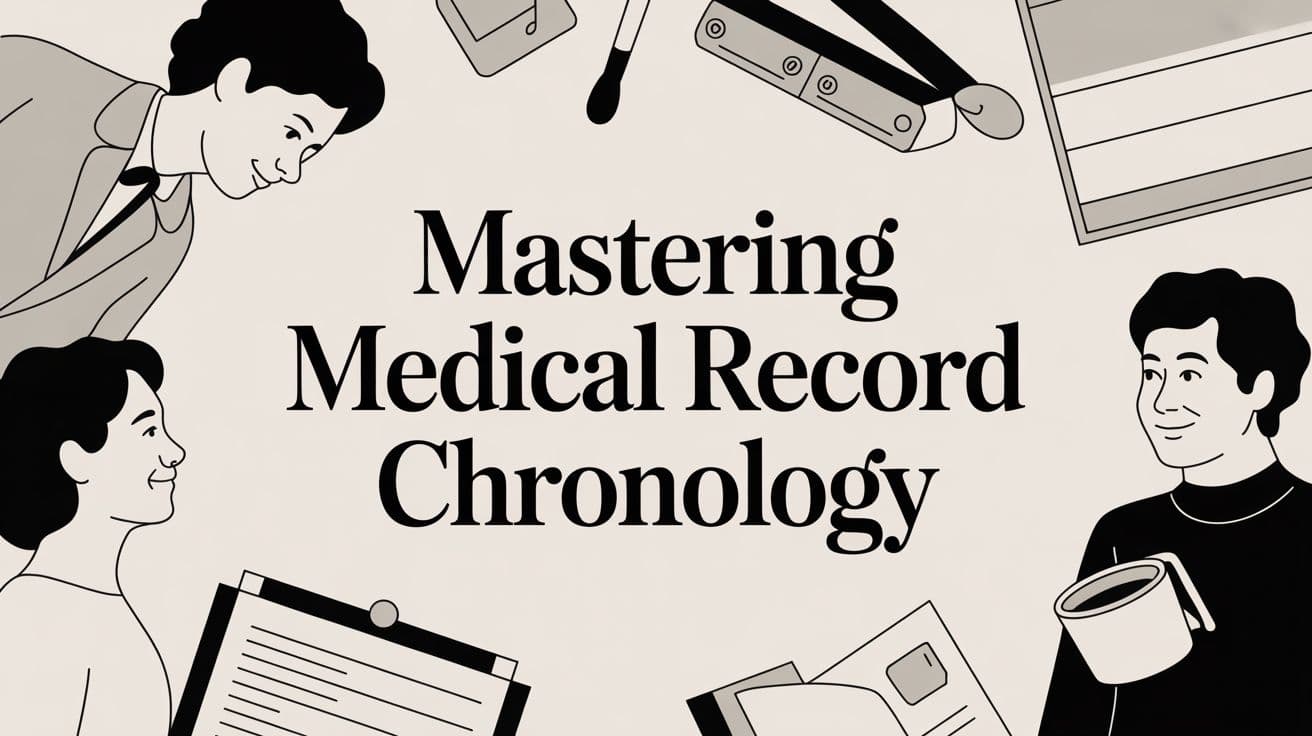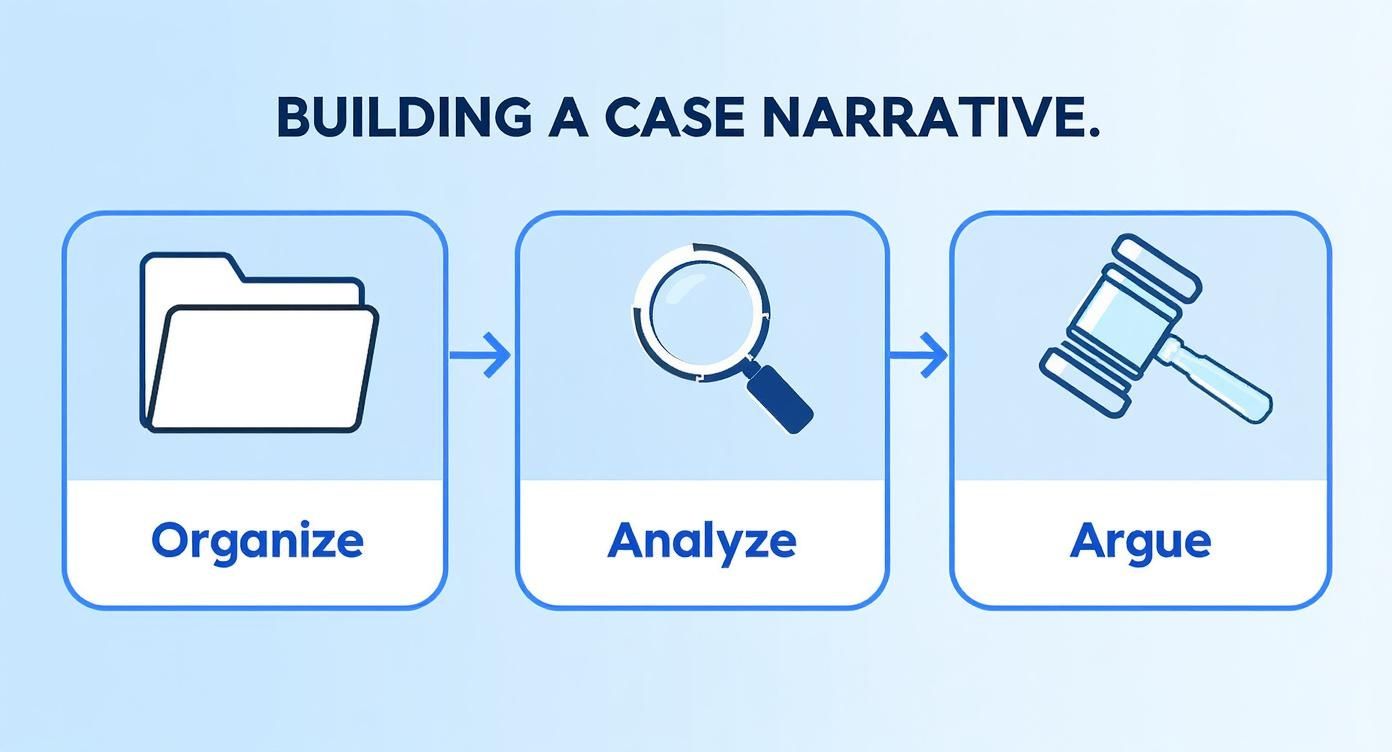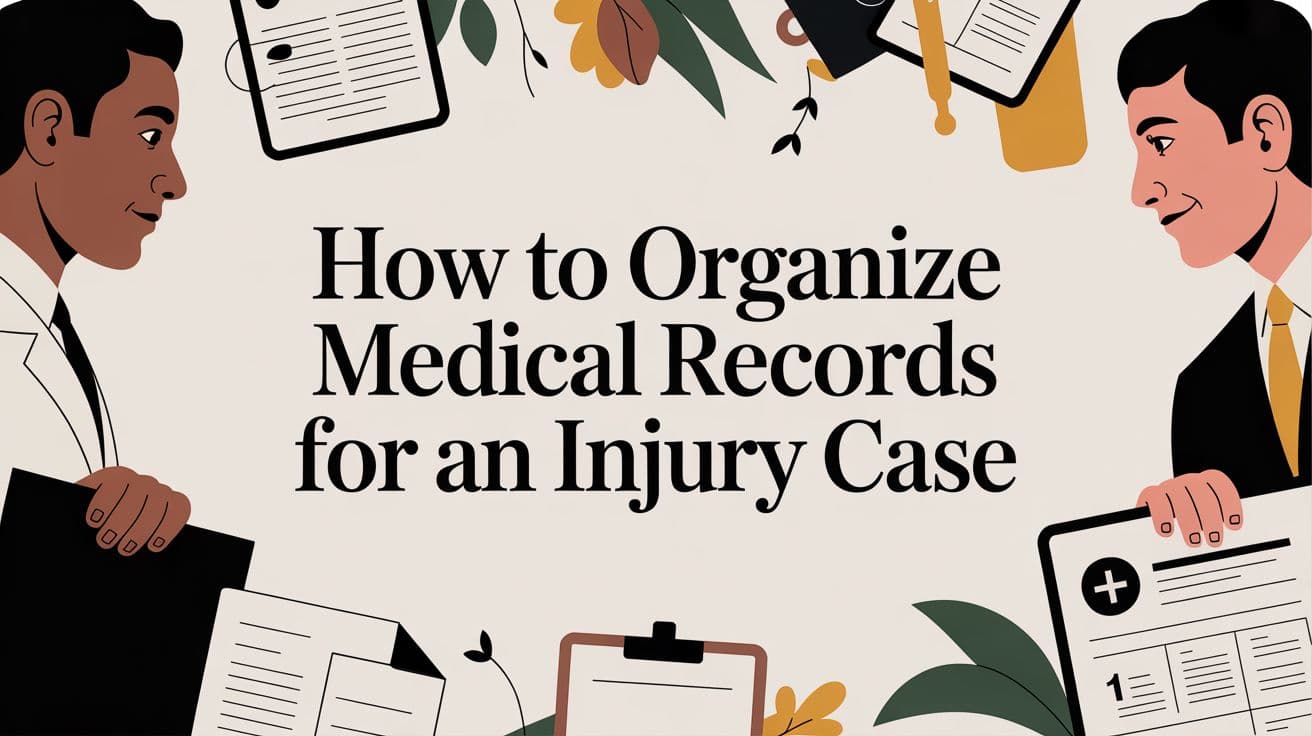Mastering Medical Record Chronology

Think of a medical record chronology as the story of a patient’s health, told in perfect order. It takes what is often hundreds or even thousands of pages of medical records—a chaotic jumble of doctor's notes, lab results, and billing codes—and arranges them into a single, easy-to-read timeline.
Unlocking the Story Within Medical Records

For a personal injury attorney, opening a new case file can feel like trying to solve a puzzle with all the pieces dumped on the table at once. You have physician notes from one specialist, imaging reports from another, and hospital discharge summaries from a third—all out of order. A medical record chronology is the tool that puts those scattered pieces together into a clear, understandable picture.
It does far more than just list dates in order. It weaves a narrative, tracing the patient’s journey from one appointment to the next. It’s like a detective’s timeline for a legal case, connecting providers, revealing treatment patterns, and shining a light on crucial details that would otherwise be lost in the paperwork.
From Simple Timeline to Strategic Tool
It’s important to understand that a simple list of appointments isn’t a true medical chronology. A professional chronology offers analytical depth that a basic timeline just can't match. It meticulously extracts the most relevant facts from a massive volume of records and presents them in a structured way, allowing legal teams to get up to speed in minutes, not days.
This organized approach is crucial for making smart, evidence-based decisions in several fields:
Legal: Attorneys use it to prove causation, assess pre-existing conditions, and build solid arguments in personal injury or medical malpractice claims.
Insurance: Adjusters depend on it to verify claims and understand the full scope of injuries, which helps move the evaluation process along much faster.
Healthcare: Even clinicians can use a clear chronology to review a patient's history, track a condition's progression, and make better-informed treatment choices.
The real value of a medical chronology is its ability to transform disorganized, dense medical data into clear, actionable information. This structure helps legal teams find the needle in the haystack, spot risk factors, and quickly pull up the exact records they need.
At its core, the chronology turns a mountain of data into a strategic asset. Instead of spending hours flipping through documents, a paralegal or attorney can instantly see the sequence of events, catch inconsistencies, and zero in on the moments that will make or break a case. This kind of clarity is priceless when it comes to settlement negotiations or presenting a compelling, fact-based story in court.
To better illustrate the difference, let's compare a simple timeline with the kind of comprehensive chronology used in legal practice.
Simple Timeline vs Comprehensive Medical Chronology
A simple list of dates and events only scratches the surface. A full chronology provides the context, details, and analysis needed to build a strong case.
| Feature | Simple Timeline | Comprehensive Chronology |
|---|---|---|
| Level of Detail | Lists basic events (e.g., "Dr. Smith visit"). | Includes detailed summaries of visits, diagnoses, treatments, medications, patient complaints, and provider notes. |
| Source Linking | Rarely links back to the source document. | Provides Bates numbers or page references, allowing for instant verification of every fact. |
| Data Analysis | No analysis; just a sequence of events. | Identifies treatment gaps, flags missing records, highlights conflicting information, and notes pre-existing conditions. |
| Key Information | May miss important but subtle details. | Extracts and flags critical information like pain scores, medication changes, and future treatment recommendations. |
| Usability | Offers a general overview. | Serves as a searchable, filterable database of the patient's entire medical history, ready for legal analysis. |
As you can see, the comprehensive chronology is an analytical tool, not just an organizational one. It’s designed to provide the deep insights that are essential for navigating the complexities of personal injury and medical malpractice litigation.
The Evolution of Medical Record Keeping

To really get why a modern medical record chronology is so powerful, you have to understand the chaos it replaced. For centuries, patient records were just a jumble of handwritten notes, random scribbles, and files stuffed away in some back-room archive. Can you imagine trying to build a legal case from that? You'd be sifting through stacks of paper with no rhyme or reason, no search function, and no way of knowing if you even had all the pieces.
This disorganization wasn't just an inconvenience; it created real problems. Following a patient's care over time was a logistical nightmare, especially if they bounced between different doctors. Each provider had their own way of taking notes, making a cohesive timeline of someone's health journey nearly impossible to assemble. This was a major roadblock for both medical analysis and legal review.
The Shift Toward Systematic Documentation
Things started to change in the early 20th century. As medicine became more sophisticated, the need for better, more standardized records was glaringly obvious. A huge step forward came in 1918, when the American College of Surgery started requiring hospitals to systematically register every patient. This was a pivotal moment—a first real push to document treatments and outcomes to actually evaluate the quality of care.
A year later, in 1919, the College went even further, introducing "treatment diaries." These were detailed, chronological logs of tests, diagnoses, and every interaction between the doctor and patient. This drive for standardization was a direct answer to the explosion of new medical specialties and diagnostic tools. You can learn more about this critical transition in the history of electronic medical records.
This shift set the stage for the organized chronologies we rely on now, moving healthcare from scattered, anecdotal notes toward structured, data-driven documentation.
Why Paper Records Pushed for a Better Way
The old way of doing things—with mountains of physical files—was the real catalyst for change. The limitations of paper records created huge obstacles that a well-structured medical chronology was built to solve.
Poor Searchability: Trying to find one specific note in a 500-page paper file was an exercise in frustration. There was no Ctrl+F, just endless page-turning and eye strain.
Inconsistent Formats: A note from a family doctor looked nothing like a surgeon’s operative report or a physical therapist’s assessment. Trying to piece them together into a single, understandable story was a puzzle.
Physical Storage Burdens: Law firms and hospitals needed massive amounts of physical space just to house patient files, which were always at risk of being lost, damaged, or misfiled.
Difficult Collaboration: Sharing records between legal and medical teams was incredibly slow. It often meant using physical couriers, which led to multiple, out-of-sync copies of the same file floating around.
The transition from unstructured paper files to organized digital chronologies was not merely about convenience. It was a fundamental change that enabled deeper analysis, clearer narratives, and stronger, evidence-based arguments in legal practice.
These challenges made it painfully clear that a better system was essential. The medical record chronology was the direct answer, designed specifically to bring order, clarity, and analytical power to even the most complex medical histories.
Weaving the Narrative of a Case
A medical record chronology isn't just some administrative list of appointments. Think of it as the strategic blueprint for your entire legal argument. It takes a mountain of dense, often conflicting medical paperwork and transforms it into a clean, linear story that a judge, a jury member—anyone, really—can follow. That clarity is its superpower.
Instead of just dumping a pile of isolated facts on the table, a good chronology connects the dots. It draws a clear, straight line from a single event to the cascade of medical treatments that followed, creating an undeniable cause-and-effect relationship. For attorneys, this is gold. It’s how you prove causation, the absolute bedrock of any personal injury or malpractice claim.
Finding the Devil in the Details
When you lay out the records this way, critical details that were buried deep in the files suddenly pop. A well-crafted chronology is like a magnifying glass, revealing subtle but crucial patterns in a patient's journey.
All at once, a seemingly minor entry—like a small bump in a pain medication prescription or a patient mentioning the same nagging symptom across multiple visits—snaps into place as part of a much larger, more significant picture. This is where the real magic of a medical record chronology happens. It doesn't just show you the information; it gives you the context to understand what it actually means.
For instance, a chronology helps you:
Isolate Pre-existing Conditions: It makes it easy to draw a bright line between a client’s old health problems and the new injuries from the incident in question.
Spot Gaps in Treatment: You can immediately see unexplained periods where the client wasn't receiving care, which could be a critical point to either defend or attack a claim.
Expose Inconsistencies: Contradictions between notes from different doctors, or even what a patient reported over time, become impossible to miss.
This detailed, sequential view gives legal and insurance pros the power to spot trends and discrepancies that are otherwise completely hidden. It sharpens the accuracy of the entire case and builds a stronger, evidence-based argument. You can discover more insights on how chronologies improve case accuracy on urbangeekz.com to see this in action.
From Analysis to Persuasion
Once you have this narrative locked down, the medical chronology becomes your go-to tool for every single phase of the legal fight. It stops being just an analytical summary and turns into a potent weapon of persuasion.
In settlement talks, an attorney can walk the other side through a concise, easy-to-follow summary of their client's medical ordeal, complete with specific page numbers backing up every single claim. This level of preparation shows you mean business and leaves very little wiggle room for disputes. When the facts are laid out that cleanly, it often pushes adjusters to evaluate the claim more seriously and make a fairer offer.
A medical record chronology isn't just about organizing the past; it's about shaping the future of a case. It provides the factual foundation needed to build a winning strategy, whether in negotiation or at trial.
If the case does head to trial, the chronology is the roadmap for your entire team. It helps you translate complex medical jargon into plain English, making your client's experience real and relatable for the judge and jury. By presenting a coherent story of injury, treatment, and the long road to recovery, you turn dry medical data into a compelling human story.
Ultimately, a strong medical chronology does so much more than list what happened. It tells the story of why it all matters, giving you the evidence-based backbone you need to build a powerful, persuasive, and successful case.
How to Create a Medical Record Chronology
Building a solid medical record chronology isn't just about listing dates. It's about taking a mountain of raw, often disorganized, medical data and turning it into a clear, factual story that can make or break a case. This process is methodical, requiring a systematic approach to gathering, sorting, and pulling out the most critical pieces of information.
The first, and arguably most important, step is document collection and organization. You need to get your hands on everything—physician’s notes, hospital discharge summaries, lab results, MRI reports, even billing statements. Once you have all the documents, the key is to sort them by the date of service, not the date the record was created. It's a small detail that makes a huge difference.
Structuring Your Chronology Template
With your records in order, the next step is to set up a template. Whether you're using a simple spreadsheet or dedicated legal software, consistency is everything. A well-structured template ensures you don't miss crucial details and makes the final document easy for anyone to understand.
Your template should have a few non-negotiable columns:
Date of Service: The exact date the medical care was provided.
Provider/Facility: Who provided the care? Note the doctor, specialist, or hospital.
Document Type: Was it a progress note, an operative report, a lab result? Be specific.
Summary of Event: This is the core. Write a concise, objective summary of the patient's complaints, the doctor’s findings, the diagnosis, and the recommended treatment.
Source Page/Bates Number: This is your citation. A direct reference to the page number in the original documents so anyone can verify the information in seconds.
A structured format like this means anyone reviewing the medical record chronology can find what they need and instantly trace it back to the source.
The strength of a chronology lies not just in what information is included, but how it's organized. A well-designed template acts as a filter, pulling the most relevant details to the surface while providing a clear path back to the source evidence.
Extracting and Summarizing with Precision
Now for the real work: data extraction. This is where you roll up your sleeves and dive into the records. It’s the most time-consuming part of the process, demanding a sharp eye for detail and a solid grasp of medical terminology. The goal here is to be an objective reporter—stick to the facts and avoid adding your own interpretations or assumptions.
Focus on capturing the vital signs of the case: diagnoses, prescriptions, treatment plans, patient-reported pain levels, and any recommendations for future care. Just as important is noting what isn't in the records. Gaps in treatment or missed follow-up appointments can be just as telling as the information that’s present.
This visual shows how you can transform a stack of organized records into a narrative that wins cases.
As you can see, the chronology is the foundation, allowing you to move from simple organization to a powerful legal strategy.
Leveraging AI for Speed and Accuracy
Let's be realistic—manually creating a detailed medical chronology can take dozens, sometimes hundreds, of hours, especially for complex cases with thousands of pages. This is where AI-powered tools are really starting to shine. These platforms can scan, organize, and summarize massive volumes of medical records in a fraction of the time it would take a paralegal or nurse reviewer.
These systems are trained to recognize key medical terms, dates, and provider details, using them to populate a chronology automatically. This doesn't just speed things up; it can significantly reduce the risk of human error. For firms looking to handle more cases without burning out their staff, this technology is worth a look. You can find more insights on our legal tech blog.
Of course, a few ground rules apply when using AI. First, make sure any tool you use is HIPAA compliant to protect sensitive patient health information (PHI). Second, always have a human in the loop. The AI-generated output needs to be reviewed for accuracy and context. Technology is there to assist your expertise, not replace it. Finally, check your export options. A useful chronology needs to be available in flexible formats like PDF, Word, or Excel for everything from internal team reviews to courtroom exhibits.
International Regulations and Patient Rights
Building a meticulous medical record chronology isn't just about crafting a stronger legal argument—it's also a matter of legal compliance and respecting fundamental patient rights. All over the world, legal frameworks have been put in place to ensure patients can access their complete medical story, which only underscores the need for a clear, chronological history.
This global movement toward transparency empowers patients, giving them a real opportunity to understand their own healthcare journey. It also puts the responsibility squarely on healthcare providers and legal teams to handle this incredibly sensitive data with precision and care. When records are properly organized chronologically, it becomes far easier to give patients the very information they are legally entitled to.
Landmark Legislation and Patient Access
While different countries have their own specific rules, the core principle is universal: patients have a right to their own information. These regulations have a direct impact on how medical records are managed, shared, and ultimately used in a legal setting.
In Canada: The Supreme Court’s 1992 decision in McInerney v. MacDonald was a watershed moment. It affirmed a patient's right to review and copy their entire medical record, fostering a new level of transparency between them and their providers.
In the United Kingdom: The Data Protection Acts and the Freedom of Information Act 2000 gave patients similarly broad rights to access their medical information, making sure they aren't left in the dark about their own health.
These legal frameworks have completely reshaped how medical records are handled, highlighting why chronological integrity is so vital for supporting both patient rights and administrative needs. You can dig deeper into these international standards for medical records on Wikipedia. The integrity of these records is everything; it’s the very foundation of trust between a patient and the systems meant to care for them.
A well-maintained medical record chronology is more than a professional tool for litigation. It is a cornerstone of transparency, accountability, and patient autonomy in modern healthcare systems worldwide.
This dedication to accessibility means that when a law firm receives a client's records, they are handling more than just a case file—they are custodians of a legally protected and deeply personal story. Organizing these documents into a chronology honors the patient's experience while simultaneously preparing it for the rigors of legal review.
Balancing Access with Data Security
As patient data has become more accessible, the need for rock-solid security has grown right alongside it. Giving a patient access to their complete medical history is both a legal and ethical duty, but it must be carefully balanced with the absolute obligation to protect that information from breaches or prying eyes. After all, a chronological summary often holds the most sensitive details of a person's life.
This is where secure platforms become non-negotiable. Any system used to create or store a medical record chronology must comply with strict data protection standards, like HIPAA in the United States. It's critical for legal teams to choose tools that guarantee the confidentiality and integrity of protected health information (PHI) every step of the way. For a closer look at this, explore our guide on legal tech security and compliance to see how you can effectively safeguard your client's data.
Common Questions About Medical Record Chronologies
Even when you know what a medical record chronology is, putting one together for the first time always brings up practical questions. Let's walk through some of the most common things legal professionals ask, giving you the straight answers you need to manage your time and resources well.
What Is the Primary Goal of a Medical Chronology?
At its heart, a medical chronology is about one thing: turning a chaotic stack of medical records into a clear, easy-to-follow story. The goal is to distill hundreds or even thousands of pages of raw medical data into a single, digestible timeline.
This condensed summary lets attorneys, insurance adjusters, and even medical experts quickly grasp the key events of a patient's care. It’s all about spotting the important patterns, identifying gaps in treatment, and making informed decisions without having to dig through every single page of the source documents.
Who Benefits Most from This Tool?
While a good chronology is useful for almost anyone involved in a case, some roles depend on it more than others. The people who get the most out of it are those building or evaluating a case based on a person’s medical journey.
Attorneys: For lawyers handling personal injury, medical malpractice, or workers' compensation claims, the chronology is the foundation of their entire case strategy.
Insurance Adjusters: They rely on chronologies to quickly validate claims and understand the true extent of injuries, which helps them process everything much faster.
Paralegals & Legal Nurse Consultants: These experts use the timeline to analyze the merits of a case, draft summaries, and arm the legal team with concrete, factual evidence.
Basically, if you need to get up to speed on the medical facts of a complex case without spending days reading, a chronology is your best friend.
A medical record chronology is the factual bedrock for a case. For a legal team, it’s not just a summary—it’s a strategic tool that turns a mountain of confusing data into a clear and powerful narrative.
How Long Does It Take to Create a Chronology?
This is the classic "it depends" question. The time it takes to build a medical record chronology hinges almost entirely on the size and complexity of the records. There’s no magic number, but we can talk about some general benchmarks.
For a straightforward case with less than 200 pages of neatly organized records, an experienced paralegal or nurse consultant might knock it out in just a few hours. But for a complex case with thousands of pages from a dozen different providers? You could easily be looking at several days, or even weeks, of painstaking work to get it right.
This is exactly where technology is changing the game. AI-powered platforms can now handle most of the heavy lifting, pulling out the key data points automatically. This dramatically cuts down the turnaround time while keeping the output incredibly accurate. If your firm is buried under a backlog of records, feel free to contact us to see how automation could help.
At Ares Legal, LLC, we're dedicated to helping personal injury firms turn complex medical records into clear, case-winning narratives. Our AI-powered platform automates the creation of medical chronologies and demand letters, saving your team over 10 hours per case. Claim bigger and settle faster with Ares Legal.


